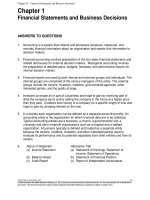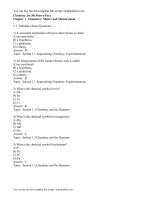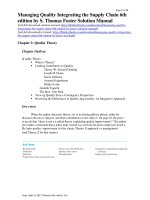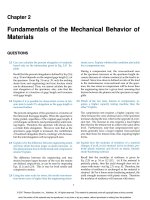Solution manual for quality 6th edition by summers
Bạn đang xem bản rút gọn của tài liệu. Xem và tải ngay bản đầy đủ của tài liệu tại đây (401.4 KB, 7 trang )
Solution Manual for Quality 6th Edition by Summers
Full file at />
Online Instructor’s Manual
to accompany
Quality
Sixth Edition
Donna C. S. Summers
Prentice Hall
Boston Columbus Indianapolis New York San Francisco Hoboken
Amsterdam Cape Town Dubai London Madrid Milan Munich Paris Montreal Toronto
Delhi Mexico City Sao Paulo Sydney Hong Kong Seoul Singapore Taipei Tokyo
Full file at />
Solution Manual for Quality 6th Edition by Summers
Full file at />
___________________________________________________________________________________________
Copyright © 2018 Pearson Education, Inc. or its affiliates. All rights reserved. Manufactured in the United States of
America. This publication is protected by Copyright, and permission should be obtained from the publisher prior to
any prohibited reproduction, storage in a retrieval system, or transmission in any form or by any means, electronic,
mechanical, photocopying, recording, or likewise. To obtain permission(s) to use material from this work, please
submit a written request to Pearson Education, Inc., Permissions Department, 221 River Street, Hoboken, New
Jersey.
Many of the designations by manufacturers and seller to distinguish their products are claimed as trademarks. Where
those designations appear in this book, and the publisher was aware of a trademark claim, the designations have been
printed in initial caps or all caps.
10 9 8 7 6 5 4 3 2 1
ISBN-13: 978-0-13-441342-6
ISBN-10:
0-13-441342-3
Full file at />
Solution Manual for Quality 6th Edition by Summers
Full file at />Table of Contents
Chapter 1
Chapter 2
Chapter 3
Chapter 4
Chapter 5
Chapter 6
Chapter 7
Chapter 8
Chapter 9
Chapter 10
Chapter 11
Chapter 12
Chapter 13
Chapter 14
Chapter 15
1
4
7
11
28
39
46
54
69
81
95
102
105
107
108
Test Bank
111
Cases
1.1 Quality Evolution
2.1 Quality Hospitals
3.1 Malcolm Baldrige National Quality Award
4.1 Problem Solving
4.2 Process Improvement
5.1 Statistics
5.2 Process Improvement
6.1 Quality Control for Variables
6.2 Process Improvement
6.3 Sample-Size Considerations
7.1 Process Capability – Hop Scotch Drive-In
7.2 Process Improvement
8.1 Precontrol
9.1 Probability
9.2 Normal Probability Distribution
10.1 Attribute Control Charts: np Charts
10.2 Attribute Control Charts: u Charts
1 1.1 Reliability: The Entire System
11.2 Reliability
12.1 Quality Function Deployment
12.2 Design of Experiments: Airplane Experiment
13.1 Costs of Quality
134
135
136
137
138
145
152
155
158
178
181
195
205
207
208
210
211
220
223
232
233
234
235
Full file at />
Solution Manual for Quality 6th Edition by Summers
Full file at />Cases
13.2 Quality Costs
14.1 Product Liability: Aircraft
14.2 Product Liability: Tires
15.1 Benchmarking
15.2 Auditing
237
251
252
280
284
iii
Full file at />
Solution Manual for Quality 6th Edition by Summers
Full file at />Chapter 1
1.2
Feigenbaum’s definition is very comprehensive and focuses on the customer. Deming’s
definition of quality, ‘non-faulty systems’ appears to be narrow on the surface, however, to
have a non-faulty system, the system must meet the expectations as identified by the
customer(s), thus enabling us to link to Feigenbaum’s definition. The definition presented by
ASQ has several similarities to Feigenbaum’s including quality as a subjective term, each
person having their own definition of quality, ability to satisfy stated or implied needs and
being free from deficiencies.
1.3
Customer determination: replacement muffler is new, not used, that it is needed.
Actual experience: does the muffler muffle? Service?
Requirements: Service at time of replacement? On time? As promised?
Technically operational: does the muffler fit the car?
Entirely subjective: cleanliness of shop? Courtesy of service people?
1.4
Clock: actual experience: what does the customer want or need from clock
Stated/unstated: tells time/decorative
Conscious/merely sensed: dimensions/nice face on clock
Technically operational/subjective: keeps time/sound of ticking
Grocery: actual experience: customer need for grocery
Stated/unstated: organic/wide variety
Conscious/merely sensed: type of food/five senses reaction to food
Technically operational/subjective: item availability/types of offerings
Doctor: actual experience: patient’s actual experience at doctor’s office
Stated/unstated: sterile equipment/clean environment/infection control and staff that
cares about infection risk
Conscious/merely sensed: answers to questions/bedside manner
Technically operational/subjective: able to prescribe medicine/able to suggest
lifestyle changes.
1.5
For example: Quality is defined by the customer’s actual experience with the product or
service. What did they think they wanted before the experience? What did they think after
they interacted with the product or service? Did they feel they achieved value for their time
and money? Productivity refers to the effectiveness with which things get accomplished,
how well are resources used.
1.6
Customer determination: does the clean clothing meet the expectations of the customer?
Actual experience: Does the clothing feel, smell, look clean while wearing?
Requirements: clean, pressed clothing
Technically operational: clean, pressed, no damage
Entirely subjective: Does the clothing look, smell, feel good?
1.7
Variation refers to the minute differences between similar products, processes, activities, or
actions.
1.8
The evolution of total quality management began with artisan work, then inspection to
maintain quality, the statistical control of quality where statistics were used to monitor and
control quality, then statistical process control encouraged process management and
1
Full file at />
Solution Manual for Quality 6th Edition by Summers
Full file at />improvement through the use of statistics, then total quality management encouraged the
application of statistical techniques to all aspects of business.
1.9
Specification: A document that states the requirements to which a given product or service
must conform.
Tolerances: the amount of variation allowed from a standard.
Inspection: Measuring, examining, testing, or gauging one or more characteristics of a
product or service and comparing the results with specified requirements to determine
whether conformity is achieved for each characteristic.
Prevention: Prevention refers to those activities designed to prevent non-conformances in
products and services.
1.10
Inspection occurs after the fact, the product has been produced, the service has been provided.
Quality control goes beyond inspection in that statistical records are kept, but again, this
information is gathered after a problem has occurred. It is not a proactive method of ensuring
the quality of a product or service. Statistical quality control expands on the concept and
performs statistical analysis on the information gathered to determine whether or not
improvements can be made to the product or service. It is only when a company practices
statistical process control that the company focuses on being proactive in the face of quality
issues. Information is used to improve the way a product is produced or a service is provided.
In total quality management the proactive philosophy is expanded and applied to all areas of
the company.
1.11
Inspection: Normally occurs at the completion of a product or service. The product or service
is compared against a standard and judged as good or bad.
Quality Control: Firms practicing quality control review their products or services by
comparing them with specifications. This information is used to design, produce, review, and
improve the item’s quality.
Statistical Quality Control: Practitioners use statistical date to analyze and solve problems.
Statistical Process Control: SPC focuses on process improvement in order to eliminate
defects.
Total Quality Management: TQM focuses on achieving customer satisfaction through system
and process improvement.
Continuous Improvement: Companies taking this approach are interested in improving
systems and processes in order to continually provide value for their customers.
1.13
Example Specifications:
Item
Specification
--------------------------------------------------------------------------------Room Cleanliness
2 sets of clean towels
Room Cleanliness
Room vacuumed daily
Pool Cleanliness
No towels/debris around pool area
Pool Cleanliness
Correct Ph
2
Full file at />
Solution Manual for Quality 6th Edition by Summers
Full file at />1.14
Wanamaker treats bases quality on the customer’s actual experience with the product or
service (return the goods and get their money back). Wanamaker considers the customer’s
value determination which relates to Feigenbaum’s customer’s needs stated or unstated,
conscious or merely sensed, technically operational or entirely subjective.
3
Full file at />









